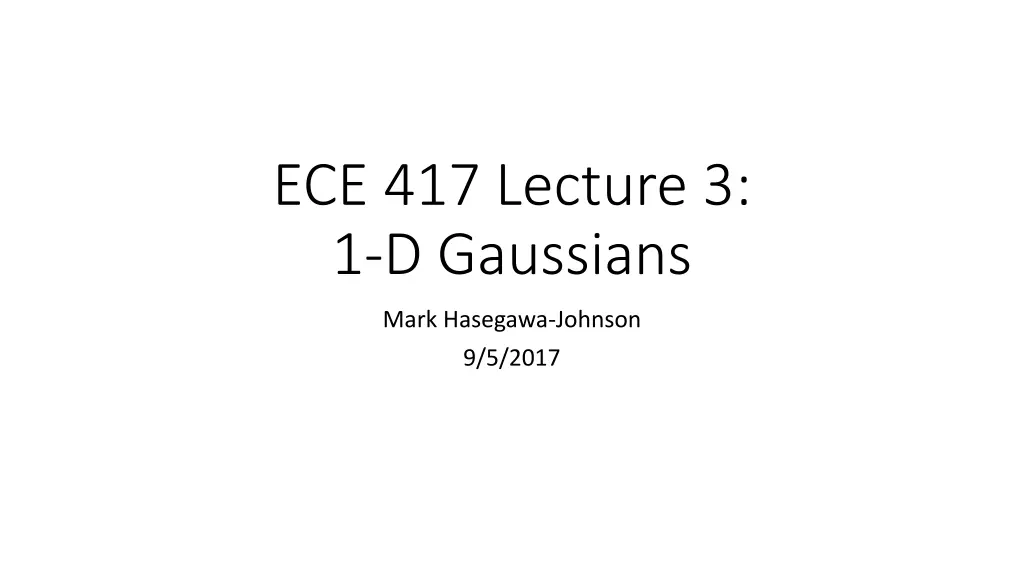
Gaussian Probability Distributions Overview
Explore the fundamentals of Gaussian probability distributions, including probability density functions, cumulative distribution functions, and the Central Limit Theorem. Learn about Gaussian PDFs, unit normal PDFs, and how to estimate distribution means using maximum likelihood estimation. Dive into examples and practical applications.
Download Presentation

Please find below an Image/Link to download the presentation.
The content on the website is provided AS IS for your information and personal use only. It may not be sold, licensed, or shared on other websites without obtaining consent from the author. If you encounter any issues during the download, it is possible that the publisher has removed the file from their server.
You are allowed to download the files provided on this website for personal or commercial use, subject to the condition that they are used lawfully. All files are the property of their respective owners.
The content on the website is provided AS IS for your information and personal use only. It may not be sold, licensed, or shared on other websites without obtaining consent from the author.
E N D
Presentation Transcript
ECE 417 Lecture 3: 1-D Gaussians Mark Hasegawa-Johnson 9/5/2017
Contents Probability and Probability Density Gaussian pdf Central Limit Theorem Brownian Motion White Noise Vector with independent Gaussian elements
Cumulative Distribution Function (CDF) A cumulative distribution function (CDF) specifies the probability that random variable X takes a value less than ?: ??? = ?? ? ?
Probability Density Function (pdf) A probability density function (pdf) is the derivative of the CDF: ? ????? ??? = That means, for example, that the probability of getting an X in any interval ? < ? ? is: ? Pr ? < ? ? = ??? ?? ?
Example: Uniform pdf The rand() function in most programming languages simulates a number uniformly distributed between 0 and 1, that is, ??? = 1 0 ? < 1 0 ?? ?????? Suppose you generated 100 random numbers using the rand() function. How many of the numbers would be between 0.5 and 0.6? How many would you expect to be between 0.5 and 0.6? How many would you expect to be between 0.95 and 1.05?
Gaussian (Normal) pdf Gauss considered this problem: under what circumstances does it make sense to estimate the mean of a distribution, ?, by taking the average of the experimental values, m = ? ?=1 1 ? ??? He demonstrated that ? is the maximum likelihood estimate of ? if 2 1 2??2? 1 ? ? ? ??? = 2
Gaussian pdf Attribution: jhguch, https://commons. wikimedia.org/wik i/File:Boxplot_vs_P DF.svg
Unit Normal pdf Suppose that X is normal with mean ? and standard deviation ? (variance ?2): 2 1 2??2? 1 ? ? ? ??? = ? ?;?,?2= 2 ? ? ? Then ? = is normal with mean 0 and standard deviation 1: 1 2?? 1 2?2 ??? = ? ?;0,1 =
Central Limit Theorem The Gaussian pdf is important because of the Central Limit Theorem. Suppose ??are i.i.d. (independent and identically distributed), each having mean ? and variance ?2. Then
Example: the sum of uniform random variables Suppose that ??are i.i.d. unit uniform random variables, i.e., ????? = 1 0 ??< 1 0 ?? ?????? ? Consider the sum, S = ?=1 ??. The CDF is ??? = ?? ?1+ + ?? ? = 1 ??1 ??? ?1+ +?? ?
Brownian motion The Central Limit Theorem matters because Einstein showed that the movement of molecules, in a liquid or gas, is the sum of n i.i.d. molecular collisions. In other words, the position after t seconds is Gaussian, with mean 0, and with a variance of Dt, where D is some constant. Attribution: lookang, https://commons.wikimedia.org/wiki/File:Brownianmotion5particles150frame.gif
Gaussian Noise Sound = air pressure fluctuations caused by velocity of air molecules Velocity of warm air molecules without any external sound source = Gaussian Therefore: Sound produced by warm air molecules without any external sound source = Gaussian noise Electrical signals: same. Attribution Morn, https://commons.wikimedia.org/wiki/File:White_noise.svg
White Noise White Noise = noise in which each sample of the signal, x[n], is i.i.d. Why white ? Because the Fourier transform, ?(?), is a zero-mean random variable whose variance is independent of frequency ( white ) Gaussian White Noise: x[n] are i.i.d. and Gaussian Attribution Morn, https://commons.wikimedia.org/wiki/File:White_noise.svg
Vector of Independent Gaussian Variables Suppose we have a frame containing N samples from a Gaussian white noise process, ?1, ,??. Let s stack them up to make a vector: ?1 ?? ? = This whole frame is random. In fact, we could say that ? is a sample value for a Gaussian random vector called ?, whose elements are ?1, ,??: ?1 ?? ? =
Vector of Independent Gaussian Variables Suppose that the N samples are i.i.d., each one has the same mean, ?, and the same variance, ?2. Then the pdf of this random vector is ? 2 1 ?? ? ? 2??2? 1 ?? ? = ? ?; ?,?2? = 2 ?=1
Vector of Independent Gaussian Variables For example, here s an example from Wikipedia with mean of 50 and standard deviation of about 12. Attribution: Piotrg, https://commons.wikimedia.org/wiki/File:Multivariate_Gaussian.png
Summary CDF = probability that X is less than or equal to x pdf = derivative of the CDF Gaussian: pdf is proportional to exp(-x^2) CLT: if you average N random variables of any kind, the pdf of the average converges to a Gaussian Brownian motion, e.g., of air molecules in warm air, is the average of many random impacts = Gaussian movement White noise = i.i.d. random samples. Gaussian white noise: samples are Gaussian and i.i.d. Gaussian vector with independent elements: pdf of the vector = product of the pdfs of the elements
